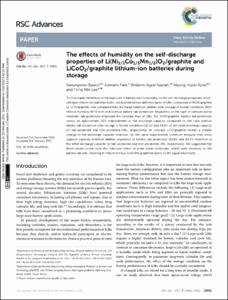Full metadata record
| DC Field | Value | Language |
|---|---|---|
| dc.contributor.author | Byun, Seoungwoo | - |
| dc.contributor.author | Park, Joonam | - |
| dc.contributor.author | Appiah, Williams Agyei | - |
| dc.contributor.author | Ryou, Myung-Hyun | - |
| dc.contributor.author | Lee, Yong Min | - |
| dc.date.available | 2017-11-26T16:13:03Z | - |
| dc.date.created | 2017-11-01 | - |
| dc.date.issued | 2017 | - |
| dc.identifier.issn | 2046-2069 | - |
| dc.identifier.uri | http://hdl.handle.net/20.500.11750/4732 | - |
| dc.description.abstract | To investigate the effects of the exposure of battery tabs to humidity on the self-discharge properties of full-cell type lithium-ion batteries (LIBs), we assembled two different types of LIBs, composed of NCM/graphite or LCO/graphite, and compared their discharge retention abilities after storage in humid conditions (90% relative humidity (RH)) with and without battery tab protection. Regardless of the type of cathode active materials, tab protection improved the calendar lives of LIBs. For NCM/graphite, battery tab protection shows an approximate 50% improvement in the discharge capacity compared to the case without battery tab protection after storage in humid conditions (51.1% and 34.6% of the initial discharge capacity for tab-protected and non-protected LIBs, respectively). In contrast, LCO/graphite reveals a smaller change in the discharge capacity retention for the same experimental condition because they show superior capacity retention abilities regardless of battery tab protection (85.6% and 82.0% retention of the initial discharge capacity for tab-protected and non-protected LIBs, respectively). We suggested that these results come from the induction effect of polar water molecules, which pulls electrons to the battery tab side, resulting in lithium ion loss from the graphene layers to the liquid electrolyte. © The Royal Society of Chemistry. | - |
| dc.language | English | - |
| dc.publisher | Royal Society of Chemistry | - |
| dc.title | The effects of humidity on the self-discharge properties of Li(Ni1/3Co1/3Mn1/3)O-2/graphite and LiCoO2/graphite lithium-ion batteries during storage | - |
| dc.type | Article | - |
| dc.identifier.doi | 10.1039/c6ra28516c | - |
| dc.identifier.scopusid | 2-s2.0-85013119856 | - |
| dc.identifier.bibliographicCitation | RSC Advances, v.7, no.18, pp.10915 - 10921 | - |
| dc.description.isOpenAccess | FALSE | - |
| dc.subject.keywordPlus | Additives | - |
| dc.subject.keywordPlus | Calendar Life | - |
| dc.subject.keywordPlus | Capacity Fade | - |
| dc.subject.keywordPlus | Capacity Retention | - |
| dc.subject.keywordPlus | Carbonateelectric Batteries | - |
| dc.subject.keywordPlus | Cathode Active Material | - |
| dc.subject.keywordPlus | Cells | - |
| dc.subject.keywordPlus | Discharge Capacities | - |
| dc.subject.keywordPlus | Electrolyte | - |
| dc.subject.keywordPlus | Electrolytes | - |
| dc.subject.keywordPlus | Experimental Conditions | - |
| dc.subject.keywordPlus | Graphene | - |
| dc.subject.keywordPlus | High Power | - |
| dc.subject.keywordPlus | High Temperature | - |
| dc.subject.keywordPlus | Humid Conditions | - |
| dc.subject.keywordPlus | Impedance | - |
| dc.subject.keywordPlus | Initial Discharge Capacities | - |
| dc.subject.keywordPlus | Ions | - |
| dc.subject.keywordPlus | Liquid Electrolytes | - |
| dc.subject.keywordPlus | Lithium | - |
| dc.subject.keywordPlus | Lithium Ion Batteries | - |
| dc.subject.keywordPlus | Lithium Alloys | - |
| dc.subject.keywordPlus | Lithium Compounds | - |
| dc.subject.keywordPlus | Manganese | - |
| dc.subject.keywordPlus | Molecules | - |
| dc.subject.keywordPlus | Performance | - |
| dc.subject.keywordPlus | Retention Ability | - |
| dc.subject.keywordPlus | Semiconductor Storage | - |
| dc.subject.keywordPlus | Storage (Materials) | - |
| dc.citation.endPage | 10921 | - |
| dc.citation.number | 18 | - |
| dc.citation.startPage | 10915 | - |
| dc.citation.title | RSC Advances | - |
| dc.citation.volume | 7 | - |
- Files in This Item:
-
 기타 데이터 / 1.6 MB / Adobe PDF
download
기타 데이터 / 1.6 MB / Adobe PDF
download
- Appears in Collections:
- Department of Energy Science and Engineering Battery Materials & Systems LAB 1. Journal Articles



